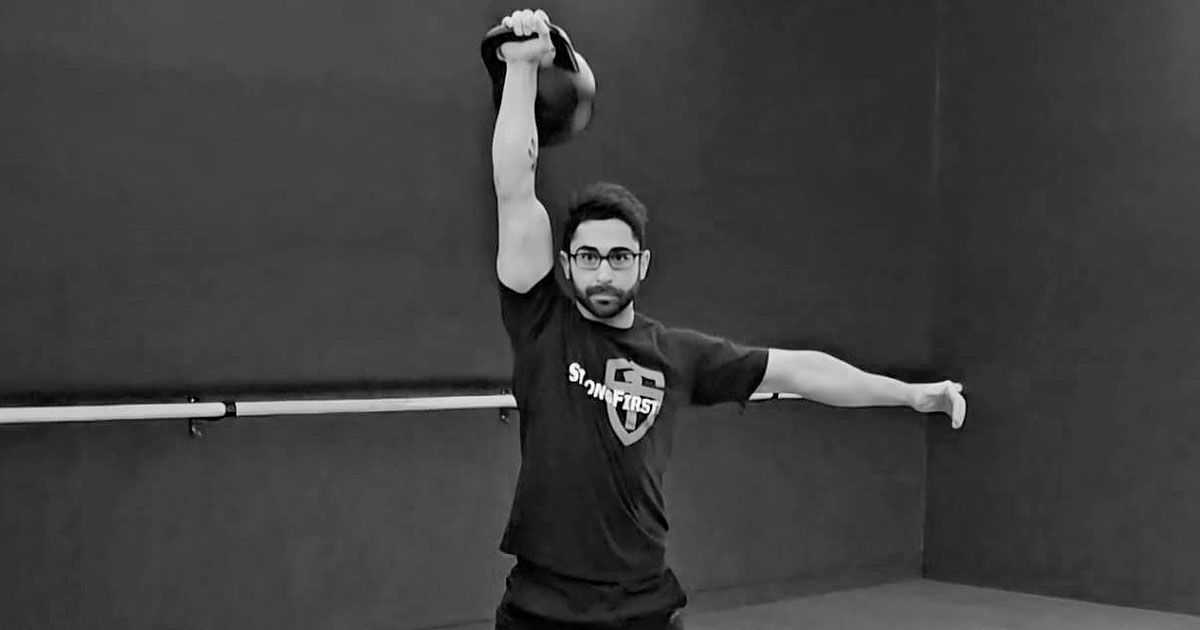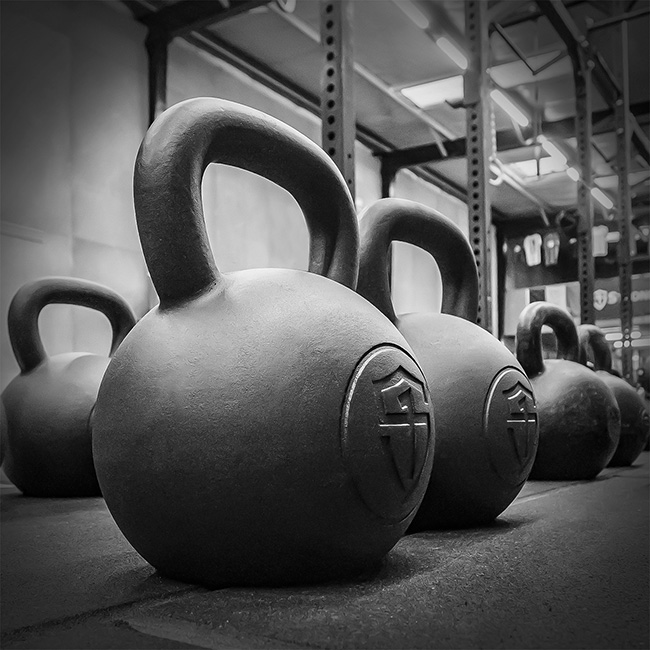
The SFG I is a challenging certification, but if I can do it, just about anyone can. I was never the most naturally gifted athlete. But with an intelligent and consistent approach to training, I was able to turn up at the event very well prepared for what was to come.
My preparation for the SFG I really started several years before I even signed up for the certification, when I embarked on a journey to snatch heavy kettlebells.
I was intrigued by some discussion that was had on the StrongFirst Forum about how snatching could make up most (if not all) of one’s resistance training if the goal is general physical preparedness. Two of the most prominent voices in this discussion were former StrongFirst Certified SFG I Instructor Al Ciampa and former StrongFirst Certified SFG II Instructor Harald Motz.
This article outlines the protocol that I have been following for some time now, that has enabled me to comfortably snatch well over half-bodyweight for some good volume. It also ensured that I was physically robust enough to not only pass the SFG I, but to fully appreciate and enjoy the experience.
I also include the peaking protocol that I used for the 5-minute snatch test. This took the general power and conditioning that I developed with regular heavy snatches and applied it to the specific demands and pace of the 5-minute test.
Before we go on, a word of warning on preparing for the SFG I. While I absolutely believe that snatches can make up the lion’s share of one’s training, remember that the snatch test is only one small part of the three-day course.
Review the standards for all six tested movements, and sprinkle in regular easy practice for them. Find a StrongFirst Certified Instructor in your area to review your movements. I was very fortunate that Claire Booth, StrongFirst Certified Senior Instructor, reached out to me offering to help me dial them in.
If you are particularly weak at any of the movements, I’d recommend following a structured strength training plan for said movement(s), alongside the snatch-focused approach that follows.

“A+A Light” Snatch Protocol
A brief note on the current working title of this snatch protocol of mine—the volume I’ve settled on is essentially about half of what Al Ciampa initially recommended to me when I first sought out guidance on A+A snatch training (A+A = alactic + aerobic).
In practice, A+A training consists of brief periods of intense work using the alactic energy pathway, broken up by long recovery periods that use the aerobic energy pathway to replenish creatine phosphate.
When done for higher volume, A+A sessions can be quite lengthy. However, my own protocol has allowed me to reap the benefits of this type of training with a much smaller time investment.
To select your initial working kettlebell, I suggest doing a technical rep max (TRM) test on your non-dominant arm. We’re looking for a kettlebell that represents a 10-20TRM. If in doubt, err towards the lighter side. Know that you’ll be going heavier eventually, so you need not let your ego get ahead of you.
As it happens, while I came to the 10-20TRM conclusion on kettlebell selection a couple of years ago, Pavel also suggests the very same thing in Kettlebell Axe.
Train 2-4 times per week using steps one and two below to establish what a given session would look like.
Step one
- Roll a die to establish the volume (never perform the same volume in two consecutive sessions, rolling again as needed).?
- NL = number of lifts (i.e., total reps per session).

*Note that the volume prescriptions are the sum of both sides. E.g., 8 x 5 = 4 sets of 5 on each side for a grand total of 40 NL.
Step two
- Roll a die again to establish whether to snatch or half snatch. This is optional, but I think there’s a lot of value in half snatching, and few people seem to talk about it. The half snatch may have done more for my pressing strength than any press-focused programs.

I usually train timeless, but using a stopwatch to dictate rest periods is an option. Five snatches every 90 seconds, and 5 half snatches every 2 minutes provide appropriate work to rest ratios.

The aim is to comfortably perform 20 x 5 of snatches within 30 minutes. If training half snatches, 20 x 5 within 40 minutes is more appropriate given that a half snatch takes longer per rep.
After I achieve these time frames, I swap out sets 5 to 8 of each session with a kettlebell 4kg heavier ((20NL total). When the target time frames are achieved again, I swap out sets 9 to 12 with a heavier kettlebell. This continues until only the first 4 sets remain with the lighter load. These are the last to be swapped out.
I wait until I have done at least five 20-set sessions in each load bracket before progressing. This is a slow and steady approach.
I suggest reviewing the progression in Pavel’s Kettlebell Simple & Sinister for moving up in weight, as this is where I drew inspiration from for this method.
The table below provides a visual representation of this progression system. I started it as written with 28kg snatches in October 2022. Without rushing, I reached Load Bracket 2 shown below with the 36kg and 40kg kettlebells in February 2024 at a bodyweight of ~75kg.

Now let’s go over how I built upon my snatch protocol and peaked for the SFG snatch test.

Five-Minute Snatch Test Peaking Protocol/Death March
This peaking protocol can be found on the StrongFirst forum. Al Ciampa is the genius behind this approach, but the post outlining the protocol was shared by Anna Cannington, StrongFirst Certified Team Leader, as below:
OK with Al’s permission, here is the peaking protocol he gave me last year as I was preparing for the TSC. It worked brilliantly!
3x each week, do 2 min of snatches with your TSC bell, in the proper cadence… do not push it. Rest 10min. Then do 1-3min of snatches with: session 1: next lower bell; session 2: TSC bell; session 3: next bell up. Rest about 1:2-3. Work until you’ve had enough (seriously). Do anywhere from 3-10 rounds of this death march. You will know when you’ve had enough.
What follows is exactly how I utilised the Death March protocol. I did two weeks of this (so six sessions), with the third week being an easy week of light practice, culminating in the SFG I weekend.
Begin each session by setting a timer for 2 minutes. With your SFG snatch test kettlebell (24kg for me), snatch at the proper cadence as many times as you can. Each rep must meet the SFG standards and a minimum of 40 reps is required.
After the 2 minutes are up, rest for 10 minutes. Then, complete each training session outlined in the table below:

Some Advice
Follow Al and Anna’s guidance: you’ll know when you’ve had enough. I did as few as 4 rounds after the 10-minute break and as many as 7.
I recommend not attempting the next round of 1 minute if you have any doubt of snatching for 20 reps (even with the 28kg). You’re peaking for a snatch test. You cannot be going any slower than 20 reps per minute. So, train like it.
For the initial 2 minutes with your SFG snatch test kettlebell, you need to complete at least 40 reps. For the 1-minute Death March, you need at least 20.

Conclusion
I firmly believe that the 5-minute snatch test is only dreaded, because so few people snatch enough in terms of volume or weight. If the heaviest that you have ever snatched is your snatch test kettlebell, then that kettlebell is always going to feel heavy, and the 5-minute test will be daunting.
The base I built snatching heavy kettlebells ensured that I was very well-conditioned for the volume of work required at the SFG I Certification.
Al Ciampa’s peaking protocol built upon this base and prepared me physically and mentally for the pace required to successfully perform 100 snatches in five minutes.
The snatch test was certainly an uncomfortable ordeal given the fatigue that had built up over the weekend. Nevertheless, I passed the test with about 15 seconds to spare. I wasn’t trying to complete the 100 reps in record time. Rather I simply stuck to 10+10 at the top of each minute (10 left, swing switch, 10 right, park the kettlebell).
I invite readers to treat the snatch as “the Tsar of kettlebell lifts” that it is. Devote more of your training to this movement. Take your time. Think years rather than months.
Whether you use my protocol or another approach is your choice. If you take this path though, not only will your snatch tests become less daunting, but you’ll become far more resilient against whatever physical demands life throws at you.
To paraphrase an ad for a Swiss watch, “You never really own a kettlebell. You merely look after it for the next generation.” If you get quality bells and take care of them, they will outlive you. You might as well get good ones—CLICK HERE!








